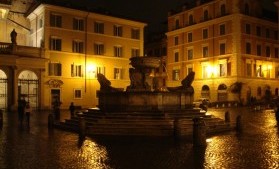Rome in three days
Only three days to visit Rome? Here follows an exciting itinerary for visitors with only a short time to discover the city’s main attractions.
FIRST DAY
Vatican area
 A – Saint Peter’s Basilica
A – Saint Peter’s Basilica
There is no better way to start your stay in Rome than visiting the beautiful Basilica of St. Peter, one of the major symbol of Christianity. The majestic Basilica, still one of the largest churches in the world, home to extraordinary works of art such as the magnificent 29-meter high bronze baldachin by Bernini, Michelangelo’s Pietà, a work that amazes for technique and emotion, the funerary monument of Clement XIII, created by the great Venetian sculptor Antonio Canova, and the splendid mosaic of the ship, built on a design by Giotto in 1305-1313. Of particular interest is the dome designed by Michelangelo. To reach it, you have to climb over 500 steps, but once achieved the top, you can enjoy a magnificent 360° view over Rome. Remember to wear appropriate clothing, people with pants or short skirts and sleeveless tops are not allowed in the basilica.
 B – Vatican Museums
B – Vatican Museums
Not so far from Saint Peter’s Basilica are located Vatican Museums where you can admire the papal apartments with Michelangelo and Raffaello’s paintings.
Museums include wonderful collections of works of art of the most prestigious in the world.
The visit takes at least half a day. To avoid the long queue at the entrance, we suggest you to allocate the whole afternoon to visit museums.
 C – Castel Sant’Angelo
C – Castel Sant’Angelo
With the Basilica at your back, walk Conciliazione street until you get to Castel Sant’Angelo, also known as the Mausoleum of Hadrian, where you can see, in addition to the National Museum, the secret passage Passetto, who joined the Vatican City with the castle, formerly used by the popes to escape from the depredations of the enemy.
SECOND DAY
From Colosseum to Trastevere
The second day of our tour takes you to the discovery of the “Ancient Rome”.
 A – Colosseum
A – Colosseum
We start off from the Colosseum, the symbol of Rome par excellence with a history stretching back almost two thousand years.
To the right of the Colosseum, here we are at the Arch of Constantine, Rome’s best-known triumphal arch. While just a stone’s through away we can see the Palatine Hill, where Romulus founded the Eternal City in 753 B.C.
 B – Roman Forum
B – Roman Forum
Moving down the Via dei Fori Imperiali we come to the Roman Forum, the political, financial and religious hub of Rome, with the Imperial Forum just across the road.
 C – Piazza Venezia
C – Piazza Venezia
Leaving Foras and heading towards Piazza Venezia, on one side of the square, you can find a large monument, often hosting major exhibitions: the Vittoriano. You can take the panoramic lifts to get to the top of the monument where you can enjoy a breathtaking view.
A little further on there is Piazza del Campidoglio, which has been centre of city government since the XII century. Michelangelo’s stunning piazza is flanked by the Capitoline Museums, the world’s oldest national museums. Justifiably taking centre stage in the piazza itself is a replica of the bronze statue of the Roman Emperor Marcus Aurelius. The original statue is to be found in the nearby museum.
 E – Mouth of Truth (Bocca della verità)
E – Mouth of Truth (Bocca della verità)
The Mouth of Truth is located in the Portico of Santa Maria in Cosmedin Church, one of the most famous churches in Rome.
 F – Trastevere
F – Trastevere
Crossing Ponte Palatino, who can stay in Rome for the evening can reach Trastevere, one of the most characteristic district of Rome, where it is a real pleasure to wander through narrow streets, squares and colors that still maintain an authentically Roman character. In addition, the neighborhood is full of typical Roman restaurants and bars where you can spend your evenings.
THIRD DAY
Renaissance Rome
 A- Piazza di Spagna
A- Piazza di Spagna
The third day we start from Piazza di Spagna, the most famous square in Rome with the monumental staircase of Trinità dei Monti and the Barcaccia Fountain.
 B – Fontana di Trevi
B – Fontana di Trevi
From Piazza di Spagna you can reach in a few minutes Piazza di Trevi, where you will find the charming Trevi Fountain, one of the most important and famous fountains in the world.
 C – Piazza Colonna
C – Piazza Colonna
From piazza di Trevi our route continues to Piazza Colonna. The square takes its name from the Column of Marcus Aurelius (it. Colonna di Marco Aurelio) that stood here since ancient times and which gives its name to the district Rione Colonna.
 D – Pantheon
D – Pantheon
From piazza Colonna our route continues to piazza della Rotonda dominated by the magnificent Pantheon building in ancient Rome, built as a temple to all the gods, past, present and future.
From piazza della Rotonda, crossed a series of narrow streets and Corso Rinascimento, you come to the overcrowded Piazza Navona, one of the most beautiful and famous squares in Rome, where you can admire: the Fountain of the Four Rivers, designed by Gian Lorenzo Bernini; the Fountain of Neptune and Fountain Moro, works of Giacomo della Porta, the Church of St. Agnes in Agony and the Palazzo Pamphili.


